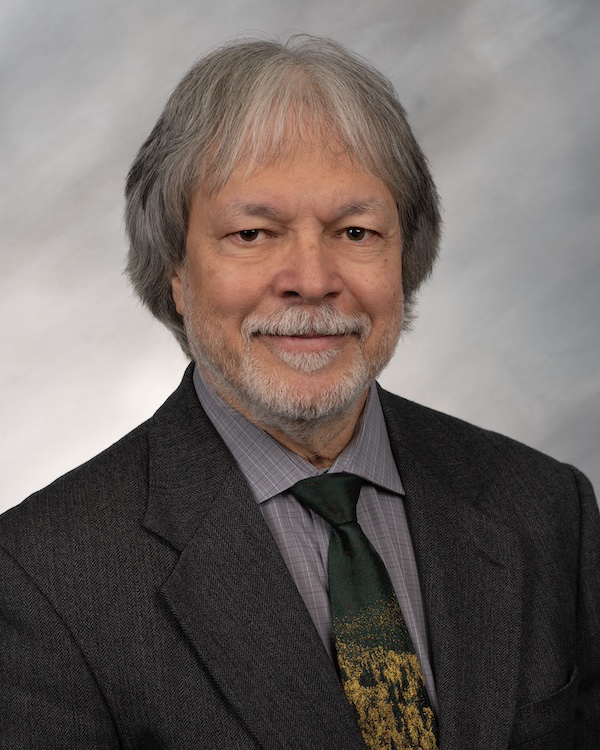Phil Pellett
Position Title
Professor
Biography
Prior to joining the School of Medicine faculty in 2007, Dr. Pellett served as Chief of the Herpesvirus Section of the U.S. Centers for Disease Control and Prevention from 1986-2003, then directed Herpesvirus Translational and Basic Research at the Cleveland Clinic from 2003 to 2007. While in Cleveland, he served as a professor of Molecular Biology and Microbiology at Case Western Reserve University, and as a professor of Molecular Medicine for the Cleveland Clinic Lerner College of Medicine of Case Western Reserve University. Dr. Pellett is a member of the Scientific Advisory Board of the Human Herpesvirus 6 Foundation, and has been a member the Herpesvirales Study Group of the International Committee for Taxonomy of Viruses since 1993; he chaired the group from 2006 to 2012. He serves on the editorial boards Virology and Journal of Virology.
Education
B.S. in Chemistry, Ohio University
Ph.D. in Virology, University of Chicago
Graduate
Accepting new MS students in 2025: No
Accepting new PhD students in 2025: No
Links of Interest
Pubmed Publications | Biosketch
Office Location
6225 Scott Hall (inside the lab)
Research
Dr. Pellett's research is aimed at understanding the biology of human herpesviruses and improving clinical outcomes of herpesvirus infections, with a focus on human cytomegalovirus (HCMV).
Research Focus
Herpesviruses: Molecular Marvels and Potent Pathogens
Dr. Pellett's research has focused on human cytomegalovirus (HCMV). Of the nine human herpesviruses, HCMV has the greatest clinical impact. It is a leading cause of congenitally acquired cerebral palsy and deafness, and is a major pathogen in immunocompromised patients. One in 150 children is born with the virus, and one in 750 is born with or will develop permanent disabilities caused by congenital HCMV. Dr. Pellett studies how HCMV remodels cells it infects, transforming them into factories that can produce infectious virus.
Cell biology of HCMV virion assembly:
HCMV induces profound changes in infected-cell morphology, including formation of large cytoplasmic inclusions that correspond to the cytoplasmic virion assembly complex (cVAC). We found that the cVAC is arranged such that Golgi- and trans-Golgi-derived vesicles are at the outer periphery of the cVAC and early endosome-derived vesicles are at its center. This counterintuitive arrangement nonetheless allows for a conventional order of membrane-protein biosynthesis and transport. The resulting model of AC structure suggests a mechanism by which the virus can regulate the order of tegument assembly. We have identified three HCMV genes that are important for cVAC biogenesis and are studying their mechanisms of action. We are also working to elucidate the pathway taken by nascent virions as they are enveloped and then transported to the plasma membrane for release.
Publications
- Krug, LT and PE Pellett. 2022. The Family Herpesviridae: a brief introduction. Chapter 8. In Fields Virology: DNA viruses, 7th ed. (beginning with 4th ed.), Vol. 2., Chapter 8. Knipe D, et al., eds. Wolters-Kluwer. pp. 212-224.
- Gatherer D, Depledge DP, Hartley CA, Szpara ML, Vaz PK, Benkő M, Brandt CR, Bryant NA, Dastjerdi A, Doszpoly A, Gompels UA, Inoue N, Jarosinski KW, Kaul R, Lacoste V, Norberg P, Origgi FC, Orton RJ, Pellett PE, Schmid DS, Spatz SJ, Stewart JP, Trimpert J, Waltzek TB, Davison AJ. ICTV Virus Taxonomy Profile: Herpesviridae 2021. J Gen Virol. 2021 Oct;102(10). PubMed PMID: 34704922.
- Komaroff AL, Pellett PE, Jacobson S. Human Herpesviruses 6A and 6B in Brain Diseases: Association versus Causation. Clin Microbiol Rev. 2020 Dec 16;34(1). PubMed PMID: 33177186.
- Wofford, AS, I McCusker, JC Green, TA Vensko, and PE Pellett. 2020. Betaherpesvirus assembly and egress: recent advances illuminate the path. Chapter 10, pp. 337-392. Advances in Virus Research, Vol. 108. Virus assembly and exit pathways. M Kielian, T Mettenleiter, M Roossinck, eds. PMID: 33837722.
- Razonable RR, Inoue N, Pinninti SG, Boppana SB, Lazzarotto T, Gabrielli L, Simonazzi G, Pellett PE, Schmid DS. Clinical Diagnostic Testing for Human Cytomegalovirus Infections. J Infect Dis. 2020 Mar 5;221(Supplement_1):S74-S85. doi: 10.1093/infdis/jiz601. PubMed PMID: 32134488; PubMed Central PMCID: PMC7057790.
- Singh S, Singh PK, Suhail H, Arumugaswami V, Pellett PE, Giri S, Kumar A. AMP-Activated Protein Kinase Restricts Zika Virus Replication in Endothelial Cells by Potentiating Innate Antiviral Responses and Inhibiting Glycolysis. J Immunol. 2020 Apr 1;204(7):1810-1824. doi: 10.4049/jimmunol.1901310. Epub 2020 Feb 21. PubMed PMID: 32086387.
- Close WL, Glassbrook JE, Gurczynski SJ, and PE Pellett. 2018. Infection-induced changes within the endocytic recycling compartment suggest a roadmap of human cytomegalovirus egress. Front. Microbiol. 9:1888. PMID: 30186245
- Close WL, Anderson AN, and Pellett. 2018. Betaherpesvirus virion assembly and egress.Adv. Exp. Med. Biol. 1045:167-207. PMID: 29896668.
- Close, WL, A Bhandari, M Hojeij, and PE Pellett. 2017. Generation of a novel human cytomegalovirus bacterial artificial chromosome tailored for transduction of exogenous sequences. Virus Res. 242:66-78.
- Pellett, PE 2017. Deep lessons from the uncultured. J. Infect. Dis. 215:1637-1639.
- Ortiz DA, Glassbrook JE, Pellett PE. 2016. Protein-protein interactions suggest novel activities of human cytomegalovirus tegument protein pUL103. J. Virol. 90:7798-7810.
- Pellett PE. 2015. Indictment by association: once is not enough. J Infect Dis. 212:509-12.
- Das S, Ortiz DA, Gurczynski SJ, Khan F, Pellett PE. Identification of human cytomegalovirus genes important for biogenesis of the cytoplasmic virion assembly complex. J Virol. 88:9086-99, 2014.
- Hladik W, Pellett PE, Hancock J, Downing R, Gao H, Packel L, Mimbe D, Nzaro E, Mermin J. Association between transfusion with human herpesvirus 8 antibody-positive blood and subsequent mortality. J Infect Dis. 206:1497-503. 2012.
- Das, S. and PE Pellett. 2011. Spatial relationships between markers for secretory and endosomal machinery in human cytomegalovirus-infected cells versus those in uninfected cells. J. Virol. 85:5864-5879.
- Das, S., A. Vasanji, and PE Pellett. 2007. Three dimensional structure of the human cytomegalovirus cytoplasmic virion assembly complex includes a reoriented secretory apparatus. J. Virol. 81:11861-11869.
